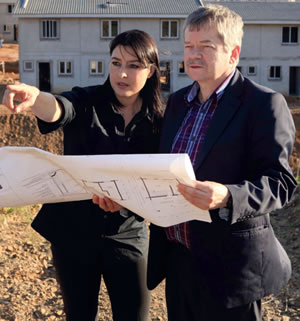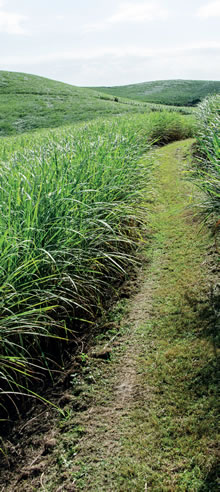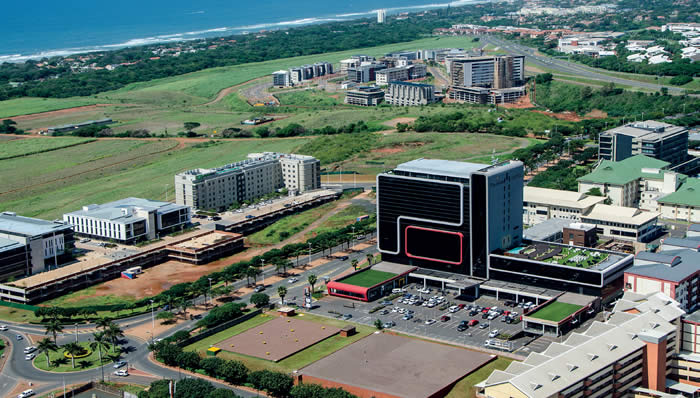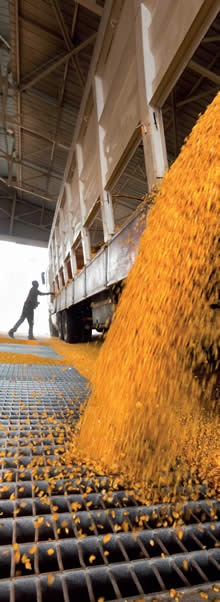chief executive's Review
 |
| Tongaat Hulett CEO Peter Staude
and Human Settlements Executive Karen Petersen at Cornubia |
Tongaat Hulett’s revenue grew by 19 percent to R14,373 billion for the 2012/13 year and headline earnings increased by 18,7 percent to R1,058 billion. Total sugar production increased by 104 000 tons (9 percent) to 1,254 million tons, after increasing by 144 000 tons (14 percent) in the prior year. The cane supplied to all the sugar mills grew to 10,3 million tons, with various ongoing cane supply initiatives. The advantage of higher overall sugar production volumes with the related benefits in the unit costs of production, were offset partially by margin pressure in the relationship of selling price movements, versus higher input costs. The starch operations benefitted from higher co-product realisations and world competitive maize costs, particularly with the new season maize in the second half of the year. An increasing number of hectares of land are moving towards becoming active developments in the land conversion activities. Overall, Tongaat Hulett’s profit from operations increased by 11,7 percent to R2,145 billion (2012: R1,921 billion), exceeding R2 billion for the first time.
The company continued to make substantial further progress on a number of multiple focus areas during the year to 31 March 2013. Achievements in the recent past provide a strong indicator of the benefits that will flow to the business and its stakeholders, as it continues to enhance its strategic position:
Prioritising the sustained increase of cane supplies to utilise the more than 850 000 tons of available unutilised milling capacity.
- In the 2012/13 season Tongaat Hulett grew sugar production by 104 000 tons and produced 1,254 million tons raw sugar equivalent. This increase was preceded by growth of 144 000 sugar tons in the previous season.
- The Zimbabwean operations, with a 28 percent increase in sugar production, were the major contributors to the overall increase in sugar tons for the 2012/13 season. This increase follows the 42 percent growth in sugar production by the Mozambique operations in the 2011/12 season. It is anticipated that, for the 2013/14 season, the South African sugar operations will substantially grow sugar production.
- Sugar production growth of 100 000 tons per annum from the existing mills is equivalent to half a typically sized sugar mill, which costs, together with infrastructure and agricultural assets, between R5 billion to R6 billion. The replacement value of the available unutilised milling capacity of more than 850 000 tons is R13,6 billion for the milling assets alone.
- Tongaat Hulett’s strategy is to facilitate an increase in cane supplies to grow sugar production. New plantings in the past year increased the area under cane by 14 103 hectares and the replanting of existing roots for the benefit of future milling seasons is ongoing, subject to suitable weather conditions prevailing. The early season forecast anticipates that these additional hectares, together with improvements in cane yields and the cane to sugar ratio, will assist the business to grow its sugar production by some 114 000 tons in the 2013/14 season.
- Weather conditions, specifically the availability of water in the Zimbabwe operations, negatively impacted on the planting of new roots and the replacement of existing roots in the 2012/13 season. The planting of cane will resume as soon as the water systems which supply these operations, including the Mutirikwi-Tokwe and the Manjirenji-Siya systems return to sustainable levels.
- The business is continuing to use emerging possibilities for cane development, to prioritise the establishment of indigenous black farmers, in collaboration with governments and other relevant stakeholders.
- In the South African sugar operations, there is a focused task to accurately map the actual area under cane supplying the four mills. To date, the process of flying over the cane supply area has been completed and the operations are in the process of verifying the information obtained with its small-scale and commercial private farmer community. This mapping process includes verifying hectares under cane, cane varieties used, land locations and private farmer details. The information will be used to populate a database that will be a reliable source of base data, for both Tongaat Hulett and the private farmers that supply its mills.
- The increase in revenue that will flow to private farmers as they increase the supply of sugar cane to Tongaat Hulett mills will continue to have a positive impact on the towns and communities that surround company operations. During the year to 31 March 2013, R2,5 billion was paid to private farmers who supplied the business’s sugar operations with cane.
- The focus remains on increasing the sugar that is contained in and extracted from the cane stalk, through improved farming practices, suitable fertilizer application, appropriate irrigation of cane, harvesting of cane at the correct age which is normally every 12-13 months and better mill performance.
 |
| Optimising revenue from sugar cane |
Reducing the unit cost of production.
- Generally 90 percent of overhead costs are fixed, between 80-85 percent of sugar milling costs are fixed and approximately 90 percent of on-farm agricultural costs are fixed or directly linked to the extent of hectares being farmed. The business will continue to ensure that it optimises the tons of cane per hectare (tcph) that is derived from land that is under sugar cane. Loading and transport costs vary depending on the distance to the sugar mill, and generally mills are supplied by sugar cane that is farmed within a 100 kilometer radius. The growth in sugar cane supplies, and subsequently sugar production, will lead to a substantial reduction in the unit cost of production.
- A comprehensive process is underway to re-examine all bought-in costs and services, which currently amounts to more than R4 billion, excluding maize and cane purchases, per annum. This process will include an examination of the quantum, value add, in house or outsource and possible longer term procurement arrangements.
Optimising revenue from sugar cane and progressing Tongaat Hulett’s renewable energy initiatives to meet the SADC region’s need for agricultural development, job creation and energy security.
- Regulatory Frameworks that are conducive to sustainability and growth of the sugar industries in which the business operates are essential. Tongaat Hulett is continuing to promote regulatory changes that will benefit all industry stakeholders in the long-term.
- The Ministerial Determination published in South Africa in December 2012 does create space for electricity from sugar cane fibre. The South African Government has indicated its intention to set up a separate programme for the Sugar Industry.
- Every 3,5 hectares of additional sugar cane planted typically creates one new job. This is an important consideration particularly when viewed within the context of the need for job creation and rural development.
- Obtaining an attractive capital return on an electricity plant and ensuring that bagasse is given the appropriate value, will contribute to an increase in the sugar cane price, which will positively impact sugar cane supplies and therefore sugar production.
- Progress is being made with the South African Government in terms of the procurement process for renewable electricity. Tongaat Hulett currently produces 52 MW at its four South African mills and this can be increased to between 320 MW - 360 MW. The capital cost of converting one sugar mill, together with making it energy efficient will currently cost some R4 billion and the coming year should see the company bid for its first 80 MW power station.
- In terms of the business’s strategic approach to ethanol production in South Africa, Tongaat Hulett is advocating a framework which would see 4 to 5 of the industry’s existing sugar mills attach a large scale ethanol plant to the back-end of the mill and possibly draw some sugar streams from other mills within close proximity. This would allow the industry to convert all export sugar to ethanol and would provide sufficient ethanol for approximately an E6 blend provided that all of South Africa’s sugar mills are running at full capacity.
 |
| Ingonyama Trust Board signing ceremony |
Increasing the pace of land conversion while establishing, maintaining and entrenching appropriate value benchmarks.
- Tongaat Hulett maximises the value of its landholdings to all stakeholders, by optimising land use between agriculture supplying its agri-processing operations and other uses through its property development activities, as competition for alternative land usage increases. The transition of prime land from agriculture to property development, with the established conversion platform and expertise, generates both capital and operating profits
- This transition to other uses in the current year resulted in 65 hectares being sold for property development, while the business’s South African sugar operations planted 11 554 new hectares to cane in the 2012/13 season.
- The business has some 8 500 developable hectares (13 500 gross hectares) in South Africa, that can be converted to other uses through sales, including bulk deals/partnerships/own developments and it is anticipated that this transition will take place over at least 20 years.
- The extent of active, “shovel ready” land will be substantially increased from the current base of 490 developable hectares, representing over R3 billion worth of profit potential, by the addition of at least a further 831 developable hectares by March 2014. This additional land brings into play a significantly wider portfolio in terms of land uses and geographic spread.
- Tongaat Hulett is actively seeking and is increasingly finding interest in bulk land sales and partnerships from entities whose interests in land are complementary to its own. The company has large, concentrated and high value landholdings around Durban and on the KwaZulu Natal coastline. Large scale, long-term strategies for these landholdings are increasingly supported and approved by key governmental and other stakeholders and there is a fundamental strategy to realise cash value from this land portfolio on an accelerated basis. The business does not undertake the development of buildings on this land, nor does it seek to develop a long term property portfolio. This positioning offers significant opportunities to entities whose profile is complementary to Tongaat Hulett’s; namely entities that do not have a significant stake in land in South Africa, more specifically, near Durban and on the KwaZulu Natal coast; have little appetite or capacity to develop the methodologies and relationships required to evolve and acquire support for a long-term strategy for such landholdings, but who see value in having such a strategy in place prior to acquisition; who have a long-term investment view and seek to, over time, unlock real capital value appreciation, access to building development and investment opportunity and recurring future cash flows from property investment in this region.
- A key driver of demand north of Durban and around the airport specifically lies in the strong alignment that has been achieved with provincial, local and national Government on driving investment into the region immediately surrounding the airport. This is giving rise to interest in bulk sales and partnerships, infrastructure investment at scale and joint promotion of investment into the region.
Evolving the starch and glucose operation’s market mixes and new product portfolios in order to optimise earnings and increase capacity utilisation.
- The increased global demand for convenience food products has encouraged the development of modified waxy starch products and represents a growth opportunity for Tongaat Hulett. The business will continue to focus on the selection of market mixes and the development of new product portfolios to maximise contribution and increase capacity utilisation. Production, from installed milling capacity, can be increased by a further 20 percent, creating opportunities for growth into Africa.
- The past year has seen the starch operation continue to capitalise on the improved competitiveness of South African maize, the key raw material for the operation.
Partnering with Governments and other key stakeholders to develop small-scale private farmers, thereby contributing to rural development and job creation around the business’s areas of operation.
- Tongaat Hulett is continuing in its efforts to grow the number of indigenous sugar cane farmers. In Mozambique, some
1 947 indigenous private farmers on 3 900 private and leased hectares supplied sugar cane to Tongaat Hulett operations. The SusCo project in Zimbabwe is ongoing and currently, at least 670 of the 872 farmers that have been allocated land in terms of the project supplied some 850 000 tons of sugar cane to the mills in the 2012/13 season. - The company is continuing with its efforts to increase the support that it provides to small-scale sugar cane private farmers in South Africa. The business’s partnership through Operation Vuselela is an example of the model underway in order to contribute to skills transfer and the development of previously unemployed rural community members.
 |
| Umhlanga Ridge Town Centre and Ridgeside Developments |
Maintaining and developing strong relationships with all of Tongaat Hulett’s stakeholders.
- Tongaat Hulett has a shareholder base that includes many Southern African and international long-term investors. The business has, over many years, established strong relationships with its shareholders and continues to participate in both local and international roadshows in order to ensure that both current and potential shareholders are kept informed of developments within the company.
- Assisting with the development of small-scale private farmers in rural communities is an important component of increasing sugar cane supplies to Tongaat Hulett’s South African mills. The signing of a co-operation agreement between Tongaat Hulett and the Ingonyama Trust Board (ITB) has formalised a framework within which the respective parties can collaborate on the enhancement of the economic and social wellbeing of rural people residing on ITB land. Based on its sugar production in the current year, the South African operations would require at least an additional 46 000 hectares producing cane at reasonable yields, in order to utilise its existing 1 million tons of milling capacity. Early indications from high level agronomic assessments indicate that the land currently available under the control of the ITB far exceeds the land required by Tongaat Hulett to fill its mills, both in terms of its availability and suitability for cane farming.
- The commercial private farmers in South Africa currently account for 70 percent of the cane that is milled in these operations. A detailed review undertaken in conjunction with commercial farmers confirmed that transport logistics was a major input cost. Tongaat Hulett and its commercial farmers have identified that significant savings could be achieved, if transport logistics was streamlined. This process, together with a range of initiatives, including the seed cane subsidy, replant assistance scheme and ripening scheme are indicative of the activities that Tongaat Hulett is undertaking as it seeks to contribute to the sustainability of this important stakeholder.
- The business values the constructive relationships that it has developed with a range of trade unions that represents a significant component of its employees in the various countries of operation. The recent minimum wage increase in South Africa for agricultural employees, and the 18 percent increase in wages during the 2012/13 years for Zimbabwean agricultural employees is contributing to a reduction in the wage gap. The company has concluded its wage negotiations for the 2013/14 year with increases of 9,04 percent, 8,5 percent and 6,6 percent being concluded in Mozambique, South Africa (sugar milling operations) and Zimbabwe respectively.
- As part of the company’s Broad Based Black Economic Empowerment deal in 2007, the Ayavuna and Sangena consortiums, rural communities via the Masithuthukisane and Mphakhathi trusts and company employees via the ESOP and MSOP trusts, became shareholders of Tongaat Hulett. The ESOP and MSOP trusts vested in August 2012, while vesting of the remaining trusts is scheduled for August 2014.
 |
| On-going management focus on manufacturing efficiency at the Starch operations |
Developing innovative models to create successful and sustainable neighbourhoods for communities in the lower socio-economic spectrum.
- Tongaat Hulett acknowledges the urgency to create visible progress in the sustainable delivery of successful neighbourhoods for communities of lower socio-economic standing in South Africa. Presently, this is a stated priority of all spheres of government and the focus of numerous disparate initiatives throughout government and by many other role players; NGO’s, businesses and civil society. The issues are complex and with many interrelationships requiring effective coordination between many stakeholders, interests and considerations. Frequently the issue is reduced to a need for housing however it is much broader than this, including housing as a source of shelter and wealth, access to education, transportation and linkage to economic opportunity, healthcare, security and other social services and effective community organisation.
- Tongaat Hulett has committed to making a significant impact in this area through its land conversion operations. The approach is firstly to build on relationships with a broad cross section of the role players in the key sectors that can have a significant impact on the issue - all spheres of government, the financial services industry, major employers, developers, the construction sector, property managers and key NGO’s. In parallel with this, a portfolio of opportunities is being identified in the available landholdings.
- Acknowledging the complexity and the present lack of a working model for this delivery, the planned approach is one of implementing proof of concept pilot initiatives at appropriate scale to create symbolic and meaningful successes, while moving progressively towards improved models of integrated best practice for delivery.
- Early pilot phases are underway or being initiated in Cornubia, while other short term opportunities are being moved towards concept adoption around King Shaka International Airport and the greater Tongaat area. The aspiration is to move towards a portfolio of 1 000 hectares of development that could ultimately yield as much as 100 000 well located and serviced homes.
Developing and building Tongaat Hulett’s human capital, while meeting the business’s internal transformation targets.
- Building capacity and capability includes the continuous assessment of the capability profiles of teams and individuals against the required competencies, and appropriate action is taken to address the gaps that are identified. Interventions that have been implemented include the clarification of roles and responsibilities, making key appointments, leadership development, talent management, job rotation and encouraging employees to embark on self-directed structured development programmes.
- The company is seeing the benefit of its diverse employee base, with a number of Zimbabwean employees currently making a significant contribution to key areas across the business.
- Tongaat Hulett was noted as one of eight companies that were commended by the Department of Labour for surpassing its numerical targets and goals, thereby showing good progress towards achieving its approved Employment Equity Plan
Maximising the benefit of owning the leading sugar brands and strong distribution networks in the SADC region.
- The South African sugar market is the largest in the Southern African Customs Union (SACU) and the per capita consumption of sugar in South Africa has grown by 14 percent since the 2007/08 season. Tongaat Hulett with its leading Huletts® brand is well positioned to continue benefiting from any further growth in domestic consumption.
- The company is poised to benefit from future growth in consumption in Botswana and Namibia with its leading Blue Crystal ® and Marathon® brands.
- The Huletts Sunsweet® brand is the leading sugar brand in Zimbabwe, and is well positioned to benefit when domestic consumption levels return to rates seen prior to hyperinflation in the country.
 |
| Zero harm approach to safety |
Entrenching an “Organisational Safety Culture” with a zero harm approach.
- The company is involved in an ongoing process, termed as a “zero harm approach”, to develop its workforce to the level where employees are no longer solely dependent on management support and systems, but rather where individuals look after each other to prevent injuries across the company.
- In addition to the activities currently underway within the business, Tongaat Hulett is focusing more attention on unsafe behaviour in the communities around its operations, with a view to training and equipping these stakeholders and thereby improving safety levels.
- Tongaat Hulett achieved a Lost Time Injury Frequency (LTIFR) of 0,094 per 200 000 hours worked in 2012/13. This was the company’s best safety performance since the formal introduction of SHE management systems.
- The ongoing progress in the area of safety was further demonstrated by the Xinavane Agricultural and Mafambisse operations which achieved 27 678 600 and 16 761 567 Lost Time Injury (LTI) free hours respectively by 31 March 2013.
- Regrettably three employees lost their lives in three separate work related accidents. Afonso Chipumbo, a mill workshop employee and Reinnicio Santos, who was employed as a security guard were killed in two separate incidents at the Xinavane operation. A third employee, Tamukaneyi Shumba, who was employed as a loading zone clerk at Hippo Valley Estates in Zimbabwe, succumbed to injuries sustained in a vehicle accident.
Continuing to make good progress in the areas of health and environmental management.
- The year to 31 March 2013 saw the company exceed its internal target of employees knowing their HIV status, with 83 percent of its headcount now knowing their status.
- Tongaat Hulett activities pertaining to water stewardship, were noted in a number of instances in the CDP Water Disclosure South Africa Report, which was released in April 2013.
FINANCIAL AND OPERATIONS REVIEW
 |
| Headline earnings exceeded R1 billion for the first time |
- Revenue grew by 19 percent to R14,373 billion (2012: R12,081 billion) with improved sugar volumes and increased land conversion sales.
- Profit from operations increased by 11,7 percent to R2,145 billion (2012: R1,921 billion), reflecting an increase for the eighth time in the past nine years.
- Cash flow from operations, before tax, grew by 56 percent to R2,126 billion (2012: R1,363 billion) which is in line with operating profit.
- Headline earnings increased by 18,7 percent to R1,058 billion (2012: R891 million), exceeding the R1 billion level for the first time.
- Annual dividends per share totalled 340 cents per share (2012: 290 cents per share), an increase of 17,2 percent.
Profit from the starch operations increased to R388 million for the year (2012: R363 million). Starch and glucose processing margins were favourably influenced by higher co-product realisations and local maize costs that were close to international prices, over the course of the full year. Domestic market volumes reflected depressed consumer demand and were similar to the prior year. Manufacturing plant performance has continued to improve.
The final maize crop for the 2011/12 season amounted to 12,1 million tons (2010/11: 10,4 million tons). The larger crop was attributable to increased plantings following higher international maize prices and global supply concerns. New season (2012/13) plantings increased to 2,78 million hectares (2011/12: 2,70 million hectares) as high international prices continued to encourage local market plantings. The expected crop for the current season of 11,6 million tons represents the sixth consecutive year in which local supplies are expected to exceed local demand. In international markets, the key US market is expected to see an increase in production for the current season despite planting delays due to wet weather. This has resulted in a reduction in international prices to US$210-US$220 per ton (2012: US$280-US$300 per ton). These local and international market conditions combined with a weaker currency are expected to continue to support South African maize production ensuring that local prices remain close to international prices.
 |
| Sweating the sugar mills to optimise capacity utilisation |
Physical maize requirements of non-genetically modified maize for Tongaat Hulett continue to be secured through a combination of contracting directly with farmers and contracting for delivery with selected grain traders. Physical stock of maize for the remainder of the season to June 2013 is in place and the requirements for the period July 2013 to May 2014 have been contracted. Maize pricing is delinked from the physical supply utilising either a toll manufacturing arrangement or a back-to-back pricing approach. The use of a third pricing mechanism which secures the local price of maize at a level relative to the international price continues to be pursued. Utilising a combination of the three methods has resulted in the maize price, on approximately 72 percent of the 2013/14 financial period’s maize requirements, being hedged at levels close to the international price of maize at March 2013. These maize prices combined with a weaker currency environment are expected to result in an improvement in margins during the first half of the 2013/14 year compared to the comparative prior period.
Commercialisation of modified food starch production for the domestic and export market is expected during the first half of the 2013/14 year allowing the starch operation to capture a share of these value added products. Following the growth in the coffee creamer sector plans to increase the supply of the existing enzyme and acid syrup capacity to support the coffee creamer sector are well advanced. This project is expected to be commissioned during the 2015 financial period.
On-going management focus in all areas of manufacturing efficiency yielded positive results and resulted in cost reductions, particularly in the area of feed and protein recoveries. The good progress made in the area of steam generation in the prior year experienced a setback during the current year following the commissioning of new coal fired boilers in Bellville and coal supply quality issues. Work on the benchmarking exercise that commenced during the prior year to highlight further opportunities is continuing.
The two Zimbabwean sugar operations generated operating profit of R630 million (US$74 million) compared to R621 million (US$84 million) last year. Sugar production increased by 28 percent to 475 000 tons (2012: 372 000 tons) as cane deliveries from private and third party farmers grew substantially. A cost increase of some 10 percent was experienced in the milling operations and in the own estate agricultural activities. In addition, the quantum of increase in cane values reported in 2011/12 was not repeated in 2012/13. Planting activities were curtailed in the latter part of the season due to dry weather conditions culminating in fewer hectares under cane at the end of the year. The weaker Euro/US$ exchange rate impacted negatively on export proceeds while the weaker average Rand/US$ impacted positively on the conversion of US$ profits into Rands.
Tongaat Hulett embarked on a comprehensive private farmer rehabilitation programme named Successful Rural Sugar Cane Farming Community Project (SusCo), a number of years ago, with the goal of rehabilitating private farmers, with the support and expertise of Tongaat Hulett, to increase their supply of sugar cane. The SusCo project will re-establish the private farmer sugar cane production area from just over 11 200 hectares at present, to 15 880 hectares, with the direct beneficiaries including hundreds of private sugar cane farmers from the Hippo Valley, Triangle and Mkwasine Mill Group areas.
The SusCo project will be followed by a number of private farmer development projects as the business progresses its objective of meaningful stakeholder value creation, while demonstrating the value that can be derived from partnering with governments, private funding institutions like BancABC and rural communities. Project Kilimanjaro (Phase 1) is the first private farmer development project and will entail the development of some 3 300 hectares of new sugar cane land in the Southern Lowveld region. The project will result in 165 new farmers employing some 1 600 employees. Based on the current cane price, this project will result in revenue of some US$18,5 million flowing into these private farmers and the surrounding rural communities.
At the current low dam levels, irrigation has been reduced and cane expansion and root replanting for both private farmers and Tongaat Hulett’s estates have been curtailed, to be resumed once dam levels recover. The business remains optimistic that the water mitigation measures put in place and the likely completion of the Tokwe-Mukorsi dam in the latter part of 2013 will enable the Zimbabwe sugar operations to sustain current levels of production, with an early season estimate that 460 000 tons sugar will be produced in 2013/14.
Operating profit in Mozambique was R421 million compared to R402 million in 2012. Sugar production in Mozambique consolidated in the year under review, following the record 42 percent increase in the prior year, and amounted to 235 000 tons (2012: 233 000 tons). Rainfall conditions in the irrigation catchment area at Mafambisse led to a reduction in that harvest. The relative strength of the Metical impacted negatively on Euro export realisations while it had a favourable effect on converting Metical earnings into Rands.
The Mozambique operations had identified the need to make significant improvements in the agricultural performance of its operations and consequently it implemented “Agriculture Improvement Plans” at both Xinavane and Mafambisse. At Mafambisse these initiatives included inter alia, improving the bulk water supply from irrigation, converting the fields from 2 mm per day to 8 mm per day, improving field drainage and gapping up poorly germinated areas. The Xinavane initiatives included improvements in irrigation control and water application, addressing concerns around weed control and improvements to drainage on the estate fields. While some of these initiatives are still ongoing, a number of them have been completed and the operations are now beginning to see improvements in yields.
Following the progress made with the agriculture improvement plans, the operations will for the foreseeable future focus their attention on reducing costs. Initiatives to be implemented include enhancements in the procurement and the stocking of major supplies like herbicides, fertilizers and spares. Attention is also being directed to reducing fuel usage through the implementation of controlled refuelling. With between 80-85 percent of sugar milling costs being fixed, there will be a reduction in unit costs with the early season estimate that 245 000 tons sugar will be produced in 2013/14 compared to the 235 000 tons produced in the previous year.
Of the 5 752 privately farmed and leased hectares, 3 900 hectares are farmed by 1 947 small and medium scale farmers.To date, 151 hectares of food crops have been developed as part of the cane expansion initiatives in Xinavane. As part of its plans to increase cane supply at Xinavane, the estate intends to develop an additional 1 945 hectares of sugar cane. This will all be developed for small and medium scale private farmers as a way of economically empowering the local communities.
Operating profit from the South African sugar operations including the downstream sugar value added activities amounted to R308 million (2012: R354 million). The agriculture, sugar milling and refining operations recorded operating profit of R52 million (2012: R93 million) and the various downstream sugar value added activities contributed R256 million (2012: R261 million). The season concluded with sugar production of 486 000 tons which was unchanged from the prior year. Local market sales were 3% below last year and consequently lower value export sales increased accordingly. With increased cost pressures, margins were under pressure. Production was impacted by the national transport strike in South Africa followed by unusually heavy rains in the last three months of the crushing season. There has been an increased level of carry-over cane from the current season into the next season.
Since the 2009/10 season the South African operations have planted 29 937 hectares of new cane as the business sought to improve cane age and crop positioning for optimal harvesting, generate better yields and increase the crop’s ability to withstand variable weather conditions. This progress was partially offset by the losses of cane to competitor mills, and using the 2007/08 season as a base, the cumulative impact of new cane planting versus cane losses will result in new plantings exceeding cane losses for the first time in the 2013/14 season. The ongoing focus on increasing sugar cane supplies to the mills will see sugar production grow by 24 percent, with an early season estimate that sugar production will reach 605 000 tons in 2013/14 year.
The operation’s sugar cane planting interventions were primarily driven through planting initiatives on communal land that involved seed cane subsidies, Project Vuselela (revival in Zulu) as well as leases and farm management contracts on commercial farms. The company has identified additional expansions of the area under cane, with at least 10 500 hectares being planned for the 2013/14 planting period.
The achievement of the actions to increase cane planting requires effective stakeholder engagement and focus. The primary stakeholders are the existing and potential small-scale and commercial private farmers, rural communities, traditional authorities, development finance institutions and local and national Government. Tongaat Hulett, with an appropriately resourced team, is seeking to position itself through these initiatives as the partner of choice with these key stakeholders. Additionally the signed co-operation agreement with the Ingonyama Trust Board (ITB) which is the custodian of some 2,7 million hectares of communal land in KZN augurs well for the business’s ability to execute its cane expansion activities.
Focus remains on developing and implementing models that ensure sustainability of the cane growth plans, particularly with respect to cane development in the communal areas. This requires direct Tongaat Hulett involvement in obtaining financing, transport, procurement of inputs and harvesting of cane from communal areas, together with corporate social and economic investment in these areas. Involvement on training and skills transfer lend further support to Government’s objective of rural development and job creation.
Tongaat Hulett is continuing in its efforts to ensure the sustainability of its small-scale and commercial private farmers, through its support of the Sugar Industry’s request to increase duty on imported sugar to the equivalent of 35 USc/lb.
In Swaziland, the Tambankulu sugar estate’s operating profit increased to R76 million (2012: R51 million). Higher sucrose prices arose from a recovery in European Union realisations received by the Swaziland sugar industry. A raw sugar production equivalent of 58 000 tons was achieved for the year (2012: 59 000 tons). The early season estimate is that production (raw sugar equivalent) for the 2013/14 year will be 58 000 tons.
Operating profit from land conversion and development grew to R350 million (2012: R215 million) with a further R16 million in capital profits (2012: R3 million) being realised. In the past year, 65 developable hectares were sold. Revenue was generated from sales in the Cornubia Industrial, Umhlanga Ridge Town Centre, Ridgeside, La Lucia Ridge Office Estate, Izinga, Kindlewood, Mount Moriah and Zimbali areas.
Fundamental drivers of land demand over the medium to longer term, including affordable housing backlogs, rising industrial land demand, major infrastructural initiatives such as the Durban Port and the King Shaka International airport and Dube TradePort, expanding tourism markets and the growing economy, continue to reinforce the transition from agricultural land to property development.
Tongaat Hulett has over an extended period of time developed the necessary skill and expertise required to enhance the value of land as it transitions from agricultural land to property development. Preparing agricultural land to becoming an active development requires a number of overlapping processes involving local, provincial and national government departments. These include strategic spatial planning by the local authorities, framework planning, environmental impact assessments, rezoning, release from agriculture and from mining, water licensing by the department of water affairs, confirmation of all necessary bulk infrastructure and sub-divisional approvals.
The centrally accounted and consolidation items component of the income statement includes a gain of R68 million in respect of a pension fund employer surplus account allocation in the conversion from a defined benefit to a defined contribution arrangement in South Africa.
 |
| Blackburn Estate, KZN |
Finance costs increased to R560 million from R507 million in the 2011/12 year and are commensurate with the level of borrowings.
Cash flow from operations, before tax, increased to R2,1 billion (2012: R1,4 billion) which is in line with the growth in operating profit. The increase in operating cash flow follows the absorption of cash totalling more than R6 billion in the numerous expansion and new sugar cane establishment programmes over the past 6 years. Tongaat Hulett’s net debt at the end of March 2013 was R4,6 billion. The replacement of significant portions of short term debt with appropriately structured long term debt has been successfully concluded.
Total net profit before the deduction of minority interests was R1,170 billion (2012: R1,021 billion). Headline earnings attributable to Tongaat Hulett shareholders amounted to R1,058 billion compared to R891 million in 2012.
A final dividend of 190 cents per share has been declared, bringing the annual dividend to 340 cents per share (2012: 290 cents per share), a 17,2 percent increase.
OUTLOOK AND CONCLUSION
Focus Areas
In the year ahead, Tongaat Hulett expects to make substantial progress in the multiple focus areas that will further enhance its strategic position.
Tongaat Hulett is in the fortunate position, in a world of sugar consumption growth of 2 percent per annum, new sugar milling capacity being costly, with good electricity and ethanol prospects, to still have more than 850 000 tons per annum of unutilised sugar milling capacity, after the growth of sugar production of 14 percent and 9 percent in the past two years respectively. A major focus remains on how to rapidly increase cane supplies to utilise the available milling capacity.
The On-going strategy to increase cane supply in South Africa is focused on commercial farmers, small-scale farmers and increasing Tongaat Hulett’s influence in cane development through leasing additional land and collaborating with Government to rehabilitate cane supply on land reform farms that have gone out of cane. Of significance, is the co-operation agreement recently concluded with the Ingonyama Trust, which controls some 2,7 million hectares of land in KwaZulu-Natal.
Tongaat Hulett’s two operations in Zimbabwe will continue to develop their positive socio-economic impact on the country. These operations employ 18 000 people and are in an important recovery, growth and expansion phase, which should create sustainable value for all stakeholders. A central part of this recovery is the substantial development of indigenous private cane farmers. As at the end of the 2012/13 season, at least 670 active indigenous private farmers, farming some 11 200 hectares and employing more than 5 600 people, supply 850 000 tons of cane which generates US$56 million in annual revenue for them. Zimbabwe, with Tongaat Hulett as a partner, has the potential to further develop indigenous private cane farmers substantially. This potential is linked to how much annual production can be achieved from the existing sugar mills. Based on Tongaat Hulett’s view of its existing mills, a further 600 farmers on 12 700 hectares could supply an additional 1,4 million tons of cane per annum. In total, all these indigenous private cane farmer developments could earn more than US$140 million gross revenue per annum and employ more than 12 000 people.
A fundamental review has been launched to re-examine all bought-in goods and services, which currently total more than R4 billion per annum for Tongaat Hulett excluding cane and maize purchases. The review is, inter alia, examining the quantum, “value add”, “in house or outsource” and possible longer term procurement arrangements. Generally 90 percent of overhead costs are fixed, between 80-85 percent of sugar milling costs are fixed and approximately 90 percent of on-farm agricultural costs are fixed or directly linked to the extent of hectares being farmed. Higher volumes and yield improvements will contribute to the reduction in the unit costs of sugar production.
The drive to optimise revenue earned from sugar cane is one of the most important strategic positioning issues. The coming year should see the compilation of a bid for the first 80MW power station following the Ministerial Determination for 800MW issued in December 2012. Planning for the project, including the environmental impact assessments and plant construction contracting processes, is well advanced. The diversion of world market export sugar to a regional ethanol regime remains a key focus area with serious interest from the oil industry to use bio ethanol as part of their options for Clean Fuels 2.
In South Africa, Tongaat Hulett is building on its good progress to date to accelerate land conversion. It has targeted some 8 500 developable hectares (13 500 gross hectares) for development. There are ongoing processes on most of the targeted land to enhance its usage and value to all stakeholders. The extent and pace of planning, in collaboration with Government, has increased substantially. At present, some 1 900 developable hectares are the subject of well advanced environmental and planning processes.
Financial Results - The Year Ahead
Tongaat Hulett’s financial results remain sensitive to movements in exchange rates, which impact particularly on export realisations and the conversion of profits from Zimbabwe and Mozambique into Rands.
The results will benefit from the projected growth in sugar production. The early season forecast is for total sugar production to grow by some 114 000 tons, with the increase coming from South Africa in this year. With the low dam levels in Zimbabwe, irrigation levels have been reduced and cane expansion and root replanting for both private growers and own estates have been curtailed, to be resumed once the dam levels recover.
The increased current focus and progress to date on reducing input costs should, to some extent, counter cost pressures. Wage increase agreements have been concluded at reasonable levels in Mozambique, South Africa and Zimbabwe.
Current dynamics point towards pressure on sugar prices in general. World prices are currently at their lowest point in 3 years. Sugar prices that will be achieved by Least Developed / African Caribbean Pacific Countries (LDC/ACPs) into the European Union for the coming year are uncertain. The market is currently over-supplied. The white sugar price is well above the world price. Sugar is being released into the market from out of quota EU beet sugar at reduced levies and from world market sugar at reduced duties. For the first time since the introduction of the current duty and quota free regime in 2009 for LDC/ACPs, the benefits of selling into the EU are being eroded. In the regional markets, a period of pressure on selling prices and pressure from imports could prevail if the world price remains low and pricing into Europe remains under pressure.
The starch operations remain well positioned. The current South African maize crop outlook of 11,4 million tons should result in another surplus production year and combined with a weakening in the currency will ensure that maize continues to be priced at levels close to international prices supporting margins in the business. Starch and glucose volumes are expected to show modest growth with depressed local market demand being offset by a growth in export volumes, with continued improvements in manufacturing performance.
A number of new land developments are likely to become active and “shovel ready” before the year end. These new developments, together with existing active developments, are attracting increasing market interest. Various sales strategies (bulk sale, partnership or own development) continue to be reviewed for each land holding and implemented as appropriate. The number of hectares converted to development in a specific time period remains variable. The next period looks promising for own development sales. There are good prospects for substantial bulk sales, with an increase in both land available and interest by prospective purchasers. Significant bulk and semi-bulk land sale offers received in the last two years have been turned down on the grounds that they did not represent optimal value.
ACKNOWLEDGEMENTS
Tongaat Hulett’s 27 sites in Botswana, Mozambique, Namibia, South Africa, Swaziland, and Zimbabwe have benefitted from the energy, effort, loyalty and commitment that its more than 40 000 employees contribute on a daily basis. I take this opportunity to acknowledge and commend you for all that you continue to do for the company as we progress delivery on our business objectives.
Being an agricultural and agri-processing business means that Tongaat Hulett has a significant footprint in the rural communities that surround its operations. The business is committed to working together with small-scale and commercial private farmers, rural communities and Governments to grow its contribution to rural development, job creation and skills transfer and, in so doing creating sustainable value for Tongaat Hulett stakeholders.
During the year, Menanteau Serfontein, the executive responsible for Human Resources, retired from the company after almost 30 years of dedicated service. Tongaat Hulett values the commitment and contribution that he made to the organisation during his career.
The business values the support that it has received from its existing long-term shareholders and endeavours to regularly update the investment community as it progresses delivery on its strategic objectives.
Tongaat Hulett has in its Chairman a leader whose calmness, strategic acumen and insight on, particularly, socio-economic-political matters, continues to highlight the contribution that he is making to the organisation. The ongoing support and guidance that we have received from the Board is highly valued.

PETER STAUDE
CHIEF EXECUTIVE OFFICER
Amanzimnyama
Tongaat, KwaZulu-Natal
23 May 2013




